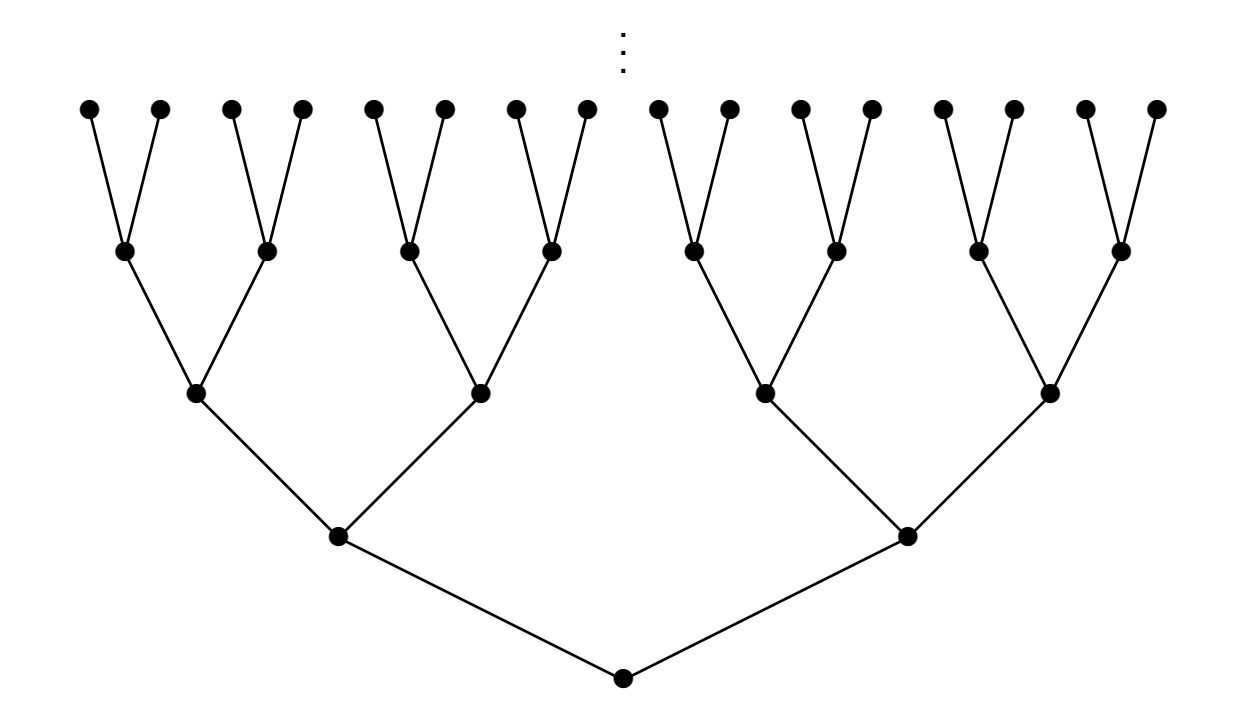On Sub-semigroup Generated by Finitely Many Morphisms
Wayne Peng
joint with J. Bell, K. Huang, T. Tucker, and S.-F. Tsai
NCTS
The set $\text{Hom}(X)$ encompassing all endomorphisms of $X$ that uphold its underlying structure typically exhibits semigroup properties by composition. What insights can be gleaned about the characteristics and properties of $\text{Hom}(X)$ in this context?
The concept involves examining the connection between any two elements, denoted as $f$ and $g$, within $\text{Hom}(X)$. Interestingly, it can lead to either uncovering a significant number of relationships between $f$ and $g$, or revealing only a few connections between them.
Topological Tits alternative(Breuillard-Gelander, 2007)
Let $k$ be a local field and $\Gamma$ a subgroup of $GL_n(k)$. Then $\Gamma$ contains either an open solvable subgroup or a dense free subgroup.
- The underlying topology is the Zariski topology.
- In this context, being an open subgroup is equivalent to being a subgroup of finite index.
- While a dense free subgroup can have an infinite number of generators, their work demonstrates the ability to confine a dense free subgroup to a finite set of free generators.
In terms of growth rate
Consider a set of characters $\Sigma=\{f,g\}$, and define $\Sigma^*$ as the collection of words composed using characters from $\Sigma$.
Let $\Sigma^*_n$ denote the set of words from $\Sigma^*$ of the length $n$.
The existence of any relation between $f$ and $g$ results in a reduction in the count of distinct words within $\Sigma^*_n$, leading to the inequality $\#\Sigma^*_n\leq 2^n$.
We say the growth rate of the semigroup $\langle f,g\rangle$ is $f(n)$ if $\#\Sigma^*_n=O(f(n))$. A polynomially bounded growth corresponds to $f(n)$ being a polynomial, while an exponentially bounded growth corresponds to $f(n)$ being an exponential function.
A Tits alternative for endomorphisms of the projective line
(Bell - Huang - :) - Tucker, upcoming on JEMS)
Let $\mathcal{S}\subset\mathbb{C}(x)$ be a finitely generated semigroup of endomorphisms of $\mathbb{P}^1$. Then either $\mathcal{S}$ has polynomially bounded growth or contains a nonabelian free semigroup (exponentially bounded growth).
- We answered a conjecture posed by Cabrera and Makienko. If the measures of maximal entropy for $f$ and $g$ are distinct, then there is a $j$ such that $\langle f^j, g^j\rangle$ is a free semigroup on two generators.
- Let $A$ be an abelian variety. Then $\text{End}(A)$ (finite morphisms from $A$ to itself) satisfies tits alternative.
Let $f,g\in\mathcal{C}(x)$ be two endormophisms of $\mathbb{P}^1_{\mathbb{C}}$, each having degree greater than $1$. Then the followings are equivalent:
- $\text{Prep}(f)\cap\text{Prep}(g)$ is infinite;
- $\text{Prep}(f)=\text{Prep}(g)$;
- for any $w_1$, $w_2\in\langle f,g\rangle$, we have $\text{Prep}(w_1)=\text{Prep}(w_2)$;
- $\langle f,g\rangle$ has polynomial growth;
- $\langle f,g\rangle$ does not contain a nonabelian free semigroup;
- for any $l>0$, the semigroup $\langle f^l,g^l\rangle$ is not free on two generators.
A counterexample
Let $f(x_1,\ldots,x_n)=(x_1^{a_{11}}\cdots x_n^{a_{1n}},\ldots,x_{1}^{a_{n1}}\cdots x_{n}^{a_{nn}})$. The degree matrix of $f$ is
$$ \deg(f)=\begin{bmatrix} a_{11} & \cdots & a_{1n}\\ \vdots & \ddots & \vdots\\ a_{n1} & \cdots & a_{nn} \end{bmatrix}. $$Let $g$ be anothor map of the same form like $f$. Then we have $\deg(f\circ g)=\deg(f)\deg(g)$.
It can be demonstrated that if neither $\deg f$ nor $\deg g$ has $1$ as an eigenvalue, then we have $\text{Prep}(f) = \text{Prep}(g) = (S^1)^n \cup \bigcup_{\text{some } i} Z_i$, where $Z_i = {x_i=0}$. We can indeed select $f$ and $g$ in such a way that $\langle \deg(f), \deg(g) \rangle$ contains a freely generated semigroup, by the Tits alternative for semigroups. Consequently, $\langle f, g \rangle$ contains a freely generated semigroup.
Algorithm:$\langle f,g\rangle$ contains free semigroup
Input: polarized morphism $f$ and $g$, and an integer $n$
Output: A Boolean indicating whether $f$ and $g$ have a composition relation, or "indeterminable" if the algorithm cannot determine by the binary tree under level $n$.
Idea of Algorithm
- For simplicity, we assume $\deg f=\deg g$.
- Composition has right cancellation, i.e.
$$
h_1\circ f = h_2\circ f\implies h_1=h_2.
$$
Therefore, to check if we have nontrivial composition relation, we can simply assume that the first (the most right) function is not the same.
- By previews lemma, if there exists some $\alpha$ such that $$ B\left(h\left(\dfrac{A(\alpha)}{d^n}\right),\dfrac{C}{(d-1)d^n}\right)\bigcap B\left(h\left(\dfrac{B(\alpha)}{d^n}\right),\dfrac{C}{(d-1)d^n}\right)=\emptyset $$ where $C=\max\{C_f, C_g\}$, $A=A_n\circ\cdots\circ A_1$ and $B=B_n\circ\cdots\circ B_1$, then any composition that starts with $A_n\circ\cdots\circ A_1$ won't be equal to one that starts with $B_n\circ\cdots\circ B_1$.
Algorithm:$\langle f,g\rangle$ doesn't contains free semigroup
- If one of the functions $f$ or $g$ in $\mathbb{C}(x)$ is not special, and $\langle f,g\rangle$ exhibits polynomial bounded growth, then it ultimately demonstrates linear growth.
- Linear growth implies that for some positive integer n, $f^n=g^n$.
- The cases that require special attention are when both $f$ and $ g$ are special.
- Monomial $x^n$: The Julia set is the unit circle centered at the origin (0,0).
- Chebyshev polynomial: The Julia set is the closed interval $[-2,2]$
- Lattès map: The Julia set is the entire space.
The only remaining case is when we have a semigroup generated by monomials like $$ \langle \zeta_1x^{n_1},\zeta_2x^{n_2},\ldots,\zeta_mx^{n_m}\rangle. $$
If $\zeta$ is a primitive fifth root of unity, then the semigroup generated by $f=x^2$ and $g=\zeta x^3$ has the following nine relations, none of which is generated by the other:
- $gf^2g=fg^2f$
- $fgfg=g^2f^2$
- $fg^4=g^4f$
- $f^2g^3=g^2fgf$
- $f^3g^2=gfgf^2$
- $f^4g=gf^4$
- $fgf^3g=gf^3gf$
- $fg^3fg=gfg^3f$
- $f^2g^2fg=g^3f^3$
A finitely generated semigroup $G=\Sigma^*/\mathcal{R}$ with the following properties:
- Let equivalent classes $[w_1]$ and $[w_2]$ belong to $G$. If $[w_1]=[w_2]$, then $|w_1|_s = |w_2|_s$ for all $s\in\Sigma$.
- There exists a positive integer $N$ such that $\#\mathcal{U}_I/\mathcal{R}\leq N$ for all indices $I$.
- The semigroup $G$ has one-side cancellation property.
:) - Tsai (2023)
If $G$ is a finitely generated semigroup satisfying the three given conditions, then the cardinality of $\mathcal{R}$ is finite and independent of how we choose relations. Moreover, the search can be completed in a finite number of steps.
